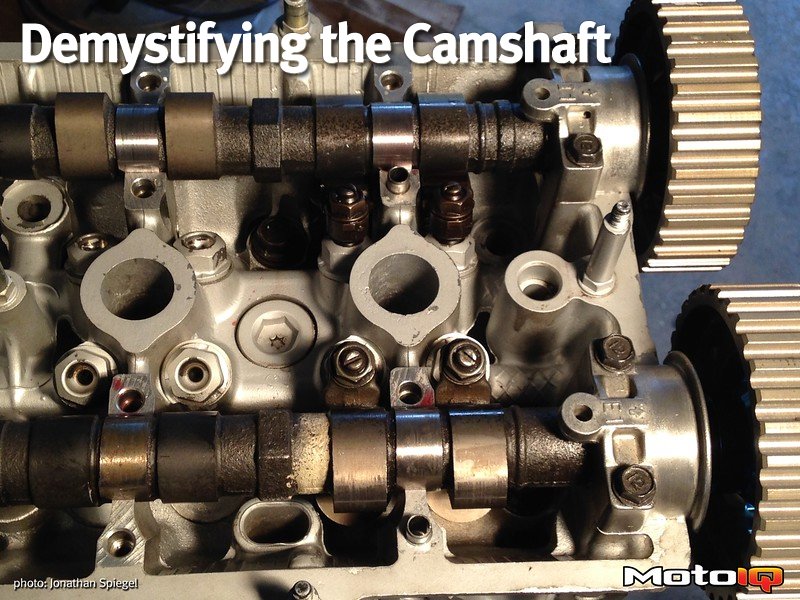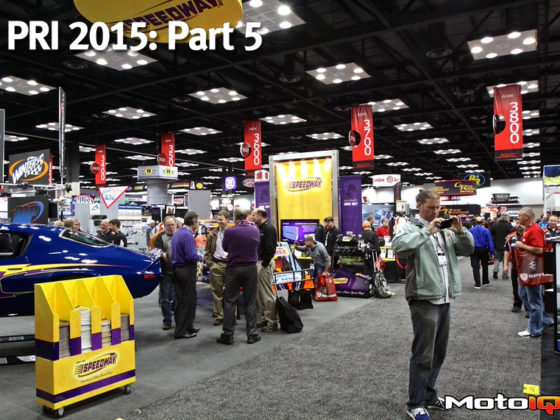,
Duration @ 0.XXX”:
This refers to the number degrees of crankshaft rotation that the valve is open, commonly measured between the point that the cam follower (rocker arm, lifter, tappet, etc…) is lifted by 0.050” and until the follower returns to the 0.050” point at closing. This number will be substantially less than advertised duration. Pay attention to where this is measured, as some manufacturers may use a different value than 0.050”
Note: based on the particular lobe profile, two cams may have the same duration at 0.050” but still have very different advertised durations. A lot can happen between the time a valve leaves the seat and the time that the follower reaches 0.050” of lift. If you compare two different cams with the same advertised duration, the one with more duration at 0.050” will generally be the more aggressive profile – meaning it opens the valves more quickly.
 Another graph of camshaft lift vs. crankshaft rotation. In this image, I’m showing two different exhaust cam profiles. While both exhaust cams have the exact same profile and duration at 0.050” lift, the cam with the red profile has more advertised duration. The valves actually open sooner and close later with the red profile. By definition, the green profile has less intensity, and therefore less overall duration in the first 0.050” of lift.
Another graph of camshaft lift vs. crankshaft rotation. In this image, I’m showing two different exhaust cam profiles. While both exhaust cams have the exact same profile and duration at 0.050” lift, the cam with the red profile has more advertised duration. The valves actually open sooner and close later with the red profile. By definition, the green profile has less intensity, and therefore less overall duration in the first 0.050” of lift.Intensity:
This is a term that describes the camshaft profile in the first 0.050” of lift. There are a three different intensity terms, attributed to Harvey Crane of Crane Cams:
Hydraulic Intensity – The number of degrees of duration between 0.004” and 0.050” of lift (measured at the cam). 0.004” is the accepted estimate of internal deflection in a hydraulic lifter when the valve starts to open.
Minor Intensity – The number of degrees of duration between 0.010” and 0.050” of lift (measured at the cam).
Major Intensity – The number of degrees of duration between 0.020” and 0.050” of lift (measured at the cam).
Lower intensity means that the valves open and/or shut more rapidly. All other things being equal, lower intensity values usually equates to better low speed performance with no loss in top end. For higher performance, high rpm applications, where low speed performance is not critical, higher intensity can be preferable because it puts less stress on the rest of the valvetrain.
Span:
Another term coined by Harvey Crane, this is simply the difference in intensity on the opening and closing sides of the cam lobe. For example, a cam with a total Minor Intensity of 30 degrees may have 15 degrees on both the opening and closing sides of the lobe profile, therefore the Minor Intensity Span would be 15.00/15.00. Span might also be asymmetrical – if the valve opens faster than it closes, the 30 degree span may be 13.00/17.00.
Lobe Centerline Angle (LCA):
This is a measurement (in crankshaft degrees) of the angle between the camshaft centerline at TDC, and the point of maximum lift on each lobe. This is measured at TDC of the exhaust stroke (overlap phase) as opposed to compression stroke. The intake centerline is expressed in degrees after TDC (ATDC) and exhaust centerline is expressed in degrees before TDC (BTDC). LCA is a very important number when it comes to installing a camshaft – it lets you know exactly where the camshaft designer wants the valves to actuate in relation to crankshaft rotation. LCA is essentially a reference – if you advance or retard the cam, then LCA changes by the same amount.
 In this graph, I’ve identified LCA and overlap. The green vertical lines designate TDC, with the green line in the center representing TDC at overlap, where both valves are open at the same time. Remember, LCA is a reference, and can be changed by advancing or retarding the cam. LSA, on the other hand, can only be adjusted in a DOHC engine – in a pushrod or SOHC motor, LSA is a fixed value determined by the cam grinder.
In this graph, I’ve identified LCA and overlap. The green vertical lines designate TDC, with the green line in the center representing TDC at overlap, where both valves are open at the same time. Remember, LCA is a reference, and can be changed by advancing or retarding the cam. LSA, on the other hand, can only be adjusted in a DOHC engine – in a pushrod or SOHC motor, LSA is a fixed value determined by the cam grinder.
 Graphical representation of LSA in a pushrod or SOHC motor.
Graphical representation of LSA in a pushrod or SOHC motor.Lobe Separation Angle (LSA):
LSA is the number of degrees of camshaft rotation between maximum exhaust lift and maximum intake lift measured at overlap. This can also be calculated by taking the sum of the intake LCA and exhaust LCA and dividing by two. The LSA tells us a lot about the amount of valve overlap at TDC of the exhaust stroke. Camshafts with “narrow” (smaller) LSAs have more overlap, and, conversely, “wider” LSAs have less overlap. On pushrod engines and SOHC engines, LSA is fixed when the cam is ground and cannot be adjusted. On DOHC engines, adjustable cam gears allow this parameter to be adjusted, providing a significant tuning advantage. Generally, cams with wider LSAs provide better idle quality and lower rpm performance, while narrower LSAs are meant for higher rpm use.
 Graphical representation of LSA in a DOHC motor. Adjustable cam gears make this easy to modify.
Graphical representation of LSA in a DOHC motor. Adjustable cam gears make this easy to modify.The absolute best way to install a camshaft properly is to use a degree wheel, which is simply a round plate that is marked at every degree (from 0 to 359) around the perimeter. This plate is bolted to the end of the crankshaft, and a fixed pointer is installed on the engine. The degree wheel is installed so that at TDC the pointer is aligned with the 0 degree mark on the wheel. Generally accepted practice is to check initial camshaft timing based on intake LCA. This is particularly important in overhead cam engines, since any machining of the deck or the head surfaces will change the distance from the crankshaft centerline to the cam centerline, retarding the camshaft timing. Cam timing is adjusted using adjustable timing gears, or, in some cases (particularly pushrod engines) through the use of offset bushings.
 A snapshot of our B18A motor going into the Polystrand GT-Lite CRX. A degree wheel is mounted to the crank, and the pointer is fixed to the block. You can just see the dial indicator on the intake valve peeking out above the intake cam gear. The engine is at TDC compression and we’re about to set the cams based on LCA of the intake cam. Since the block has been decked and the head shaved, we needed to advance the cams in order to set them up at the recommended starting point.
A snapshot of our B18A motor going into the Polystrand GT-Lite CRX. A degree wheel is mounted to the crank, and the pointer is fixed to the block. You can just see the dial indicator on the intake valve peeking out above the intake cam gear. The engine is at TDC compression and we’re about to set the cams based on LCA of the intake cam. Since the block has been decked and the head shaved, we needed to advance the cams in order to set them up at the recommended starting point.With a degree wheel and dial indicator, you also have the capability to create your own graphs of lift vs. crankshaft rotation, like the charts shown here. While you can use a spreadsheet application to generate the plots, you can get a pretty good idea of what’s going on by plotting the points on graph paper. It’s a great way to spot the differences in camshaft profiles that appear very similar, but vary greatly in performance. Degree wheels and dial indicators are fairly inexpensive as well, and they’re great tools to have when building and tuning an engine.



